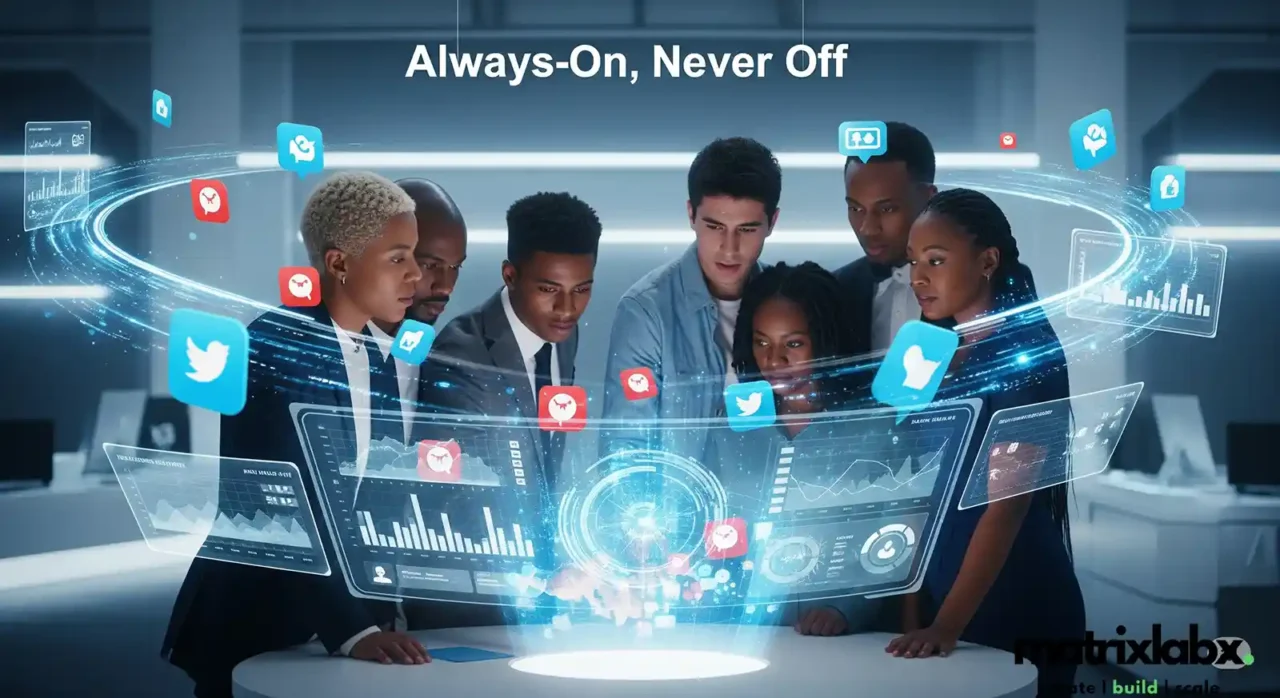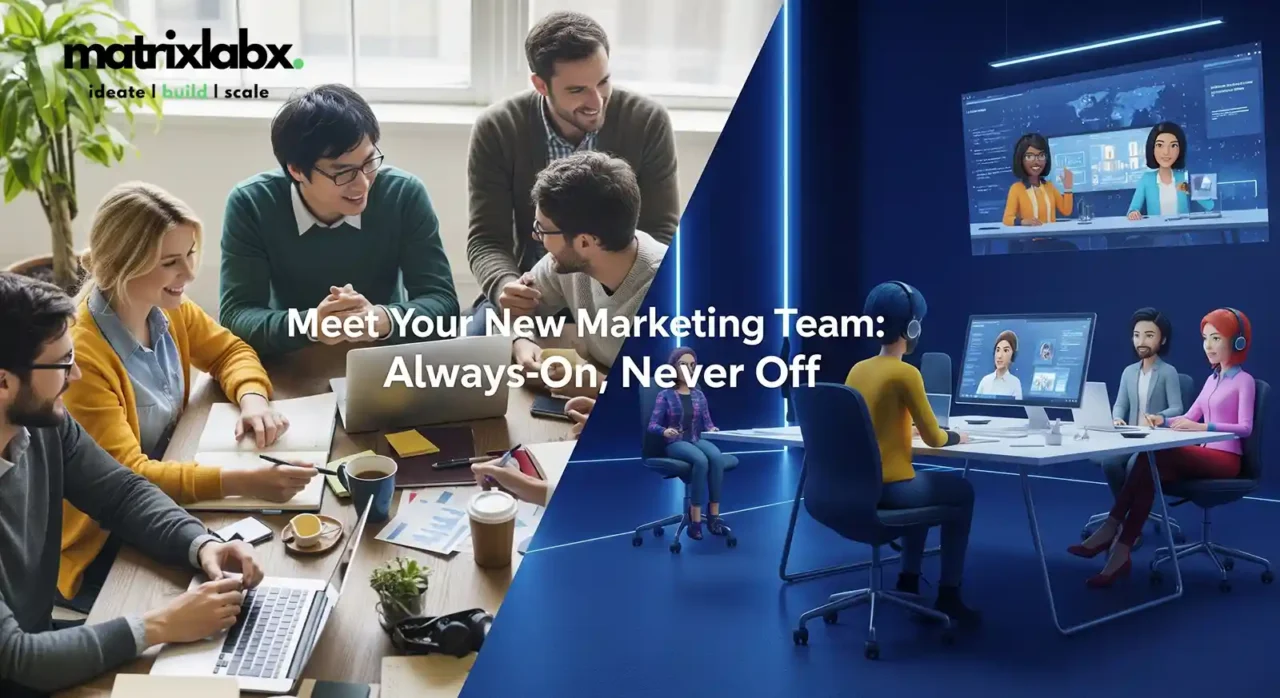The Rise of Autonomous Marketers
Learn About The Rise of Autonomous Marketers: Navigating the Future of Marketing with AIPads.
Imagine upgrading from a trusty GPS to a sleek, self-driving car. Suddenly, your journey is seamless, intuitive, and more efficient. This is the transformation currently underway in the world of marketing. Welcome to the era of autonomous marketers.
As marketing managers, you’ve navigated the complex landscape of consumer behavior, analytics, and strategy. You’ve relied on tools and data to guide your campaigns, like a GPS directing you through unfamiliar terrain.
But what if your marketing strategy could evolve into a self-driving powerhouse that anticipates customer needs and optimizes real-time campaigns?
Autonomous marketers are revolutionizing the industry, leveraging advanced AI and machine learning to automate and enhance every aspect of the marketing process.
These intelligent systems can analyze vast amounts of data, predict trends, and personalize content with pinpoint accuracy—all without human intervention. It’s like having a marketing team that never sleeps, continuously learning and adapting to ensure your brand stays ahead of the curve.
Imagine freeing your team from routine tasks, allowing them to focus on creative strategy and innovation. Autonomous marketers offer this freedom, providing insights and recommendations that drive growth and engagement.
They transform raw data into actionable intelligence, enabling you to make informed decisions more quickly and accurately. Agent as a Service: Faster, Cheaper, and Better Marketing
Annual Marketing Budget Calculator
This shift is not just about efficiency; it’s about empowerment. By embracing autonomous marketing technologies, you gain a competitive edge, enabling your brand to connect meaningfully with audiences.
As the marketing landscape evolves, those who adapt will thrive, leading the charge into a new era of customer engagement.
Are you ready to upgrade your marketing strategy and embrace the future?
Dive into the world of autonomous marketers and discover how this cutting-edge technology can propel your brand to new heights.
- According to a recent report by Gartner, global IT spending is projected to reach $4.6 trillion in 2023, reflecting a 5.1% increase from the previous year. Increased investments in cloud services and digital transformation initiatives drive this growth.
- A study by McKinsey & Company reveals that 70% of companies have accelerated their digital transformation efforts in response to the COVID-19 pandemic. This shift is primarily focused on enhancing customer experience and operational efficiency.
- The International Data Corporation (IDC) forecasts that worldwide spending on artificial intelligence systems will reach $154 billion in 2023, marking a 26.9% growth from 2022. This surge is largely attributed to the adoption of AI technologies across various sectors, including healthcare and finance.
Poor Marketing ROI
Presence-Building Vehicle Selector
Choose the right marketing vehicles based on your brand’s bottlenecks and goals.
Your Top Marketing Recommendations
Disclaimer: These recommendations are a starting point. A comprehensive strategy requires deeper market analysis.
In the fast-paced marketing world, achieving a strong return on investment (ROI) is a constant challenge. Many organizations find that despite investing heavily in campaigns, the returns often fall short of expectations.
This issue can be attributed to several factors, including poorly targeted audiences, inefficient resource allocation, and the inability to adapt to real-time data. As marketing landscapes evolve, the need for more sophisticated tools and strategies becomes evident.
Traditional marketing platforms often provide dashboards that display metrics and analytics. However, these dashboards require manual interpretation and action, leading to delayed responses and missed opportunities. Structured AI Outputs: Navigating the Future of Marketing
For CMOs, CROs, and RevOps leaders, this delay in action can mean the difference between a successful campaign and a failed one.
A comprehensive cost comparison reveals that adopting the integrated MatrixLab AI product line can offer significant savings, potentially over 60% annually, compared to the overhead of a traditional seven-person marketing team.
This analysis outlines the projected annual expenses, providing a clear financial framework for strategic decision-making.
Most Platforms Give You Dashboards. MatrixLabX Gives You Agents
The introduction of MatrixLabX represents a paradigm shift in how marketing performance is managed and optimized. Unlike traditional platforms offering dashboards, MatrixLabX provides agents with self-learning and task-executing digital team members.
These agents are designed to analyze, adapt, and act autonomously, offering a proactive approach to marketing management.
For CMOs and other marketing leaders, MatrixLabX's value lies in its ability to transform raw data into actionable insights without constant human intervention.
These digital agents continuously learn from data patterns, enabling them to optimize campaigns in real time. This enhances marketing efficiency and significantly boosts ROI by ensuring that resources are allocated where they are most effective.
For CMOs, CROs, RevOps Leaders, and SaaS Buyers Evaluating Platforms

The right platform is crucial for decision-makers such as CMOs, CROs, and RevOps leaders.
The need for more dynamic and responsive marketing strategies drives the shift towards platforms like MatrixLabX, which offer advanced capabilities beyond traditional dashboards. These leaders are increasingly recognizing the benefits of AI-driven solutions that can handle complex data and execute tasks with precision.
SaaS buyers evaluating platforms must consider the long-term impact of their choice. Investing in a platform that offers intelligent agents can lead to sustained improvements in marketing ROI and operational efficiency.
MatrixLabX's ability to self-learn and adapt ensures that marketing strategies remain relevant and effective in an ever-changing digital landscape.
In conclusion, as the marketing industry continues to evolve, the importance of leveraging advanced technologies, such as those offered by MatrixLabX, cannot be overstated.
MatrixLabX empowers marketing leaders to achieve better ROI and maintain a competitive edge by providing self-learning agents that analyze, adapt, and act.
For CMOs, CROs, RevOps leaders, and SaaS buyers, embracing such innovations is not just an option but a necessity for future success.
Step-by-Step Implementation: The Rise of Autonomous Marketers to Solve Poor Marketing ROI

Step 1: Conduct a Thorough Market Analysis
- Objective: Understand the current marketing landscape and identify areas of improvement.
- Action: Analyze existing marketing strategies, customer data, and ROI metrics. Use AI tools to identify patterns and inefficiencies.
Step 2: Define Clear Objectives
- Objective: Establish what you aim to achieve with autonomous marketing.
- Action: Set specific, measurable goals such as increasing conversion rates, reducing customer acquisition costs, or improving customer engagement.
Step 3: Select an AI Marketing Platform
- Objective: Choose the right AI tools to automate and optimize marketing efforts.
- Action: Evaluate platforms based on features like predictive analytics, customer segmentation, and personalized content creation. Consider options like AI Ultra paired with your industry model and functional AI workers.
Step 4: Integrate AI with Existing Systems
- Objective: Ensure seamless operation and data flow.
- Action: Work with IT to integrate the AI platform with CRM systems, data warehouses, and other marketing tools. Ensure data compatibility and security.
Step 5: Automate Data Collection and Analysis
- Objective: Gather real-time insights for informed decision-making.
- Action: Set up AI-driven data collection processes to track customer behavior, campaign performance, and market trends. Use analytics to adjust strategies proactively.
Step 6: Implement Personalized Marketing Strategies
- Objective: Enhance customer engagement and conversion rates.
- Action: Use AI to create personalized content, offers, and recommendations based on customer data and behavior patterns.
Step 7: Optimize Campaigns Continuously
- Objective: Improve marketing ROI through ongoing adjustments.
- Action: Leverage machine learning to test and optimize campaigns automatically. Implement A/B testing and adjust strategies based on performance data.
Step 8: Monitor and Report Results
- Objective: Track progress and demonstrate ROI improvements.
- Action: Use AI analytics to generate reports on key performance indicators (KPIs). Review these reports regularly to assess the impact of autonomous marketing.
Step 9: Train and Upskill Your Team
- Objective: Ensure your team can utilize AI tools effectively.
- Action: Provide training sessions on the chosen AI platform and its features. Encourage continuous learning to keep up with AI advancements.
Step 10: Scale and Innovate
- Objective: Expand successful strategies and explore new opportunities.
- Action: Identify scalable strategies and replicate them across different channels or markets. Stay informed about new AI developments to maintain a competitive edge.
By following these steps, businesses can leverage autonomous marketers to significantly enhance marketing ROI, resulting in more efficient, data-driven, and customer-centric marketing strategies.
Search Analytics Calculator
Measure the effectiveness of your search features.
Task Success Rate
Calculate the percentage of users who successfully completed their search task.
Conversion Rate from Search
Calculate the percentage of searches that led to a conversion (e.g., purchase, sign-up).
Click-Through Rate (CTR)
Calculate the percentage of impressions that resulted in a click on a specific search result.
The Rise of Autonomous Marketers: Transforming Marketing ROI
Case Study 1: Tech Innovators Inc.
Background: Tech Innovators Inc., a mid-sized technology company, faced challenges with poor marketing ROI due to fragmented data and inefficient campaign management.
Their marketing team struggled to personalize content and optimize ad spend effectively.
Solution: Tech Innovators Inc. implemented an AI-powered autonomous marketing platform that integrated all marketing channels into a single dashboard. The platform analyzed customer behavior and preferences, automatically adjusting real-time campaigns.
Results:
- Increased ROI by 35%: The AI-driven platform optimized ad spend, focusing on high-performing channels.
- Enhanced Customer Engagement: Personalized content delivery led to a 40% increase in customer interactions.
- Streamlined Operations: Reduced manual tasks by 50%, allowing the marketing team to focus on strategic initiatives.
Conclusion: The autonomous marketing solution enabled Tech Innovators Inc. to significantly improve ROI by leveraging data-driven insights and automation.
Case Study 2: Fashion Forward Retail
Background: Fashion Forward Retail, a leading fashion brand, experienced a decline in ROI from traditional marketing strategies.
Their challenge was to effectively engage a diverse customer base across multiple regions.
Solution: The company adopted an AI-powered autonomous marketing system to automate customer segmentation and tailor campaigns to specific demographics.
The system utilized machine learning to predict trends and customer preferences.
Results:
- ROI Boost of 50%: Targeted campaigns resulted in higher conversion rates and reduced customer acquisition costs.
- Improved Customer Insights: The AI provided deep insights into customer behavior, enabling more effective product recommendations.
- Global Reach: Managed localized campaigns across different regions, increasing brand visibility.
Conclusion: Fashion Forward Retail transformed its marketing approach, achieving higher ROI through precise targeting and personalized customer experiences facilitated by autonomous marketing.
Case Study 3: HealthPlus Wellness
Background: HealthPlus Wellness, a healthcare provider, faced challenges with low engagement and high churn rates. Their marketing ROI suffered due to generic messaging and a lack of data integration.
Solution: The company deployed an autonomous marketing solution that integrated CRM data with AI analytics. The system automated personalized outreach and optimized content based on patient interactions.
Results:
- ROI Improvement of 45%: Enhanced targeting and personalization increased patient retention and acquisition.
- Reduced Churn Rate by 30%: Personalized communication improved patient satisfaction and loyalty.
- Efficient Resource Allocation: Automated processes reduced marketing costs and improved resource utilization.
Conclusion: HealthPlus Wellness successfully revitalized its marketing strategy, achieving significant ROI improvements by implementing autonomous marketing technologies.
The rise of autonomous marketers is revolutionizing the marketing landscape.
By leveraging AI and automation, businesses can overcome challenges related to poor marketing ROI, drive growth, and enhance customer engagement.
These case studies highlight the transformative impact of autonomous marketing solutions across various industries.
FAQs: The Rise of Autonomous Marketers and Solving Poor Marketing ROI
- What are autonomous marketers? Autonomous marketers refer to AI-driven systems and tools that automate marketing tasks, allowing for more efficient and data-driven decision-making. They leverage machine learning and data analytics to optimize campaigns and improve outcomes.
- How do autonomous marketers improve ROI? Autonomous marketers enhance efficiency and precision by automating repetitive tasks, personalizing customer interactions, and providing real-time insights. This leads to better-targeted campaigns, reduced waste, and improved return on investment (ROI).
- What tasks can autonomous marketers handle? They can manage tasks such as customer segmentation, content personalization, A/B testing, predictive analytics, and campaign optimization, allowing human marketers to focus on strategy and creative aspects.
- Why is poor marketing ROI a common problem? Poor marketing ROI often results from inefficient targeting, lack of personalization, and misallocation of resources. Without data-driven insights, campaigns can miss their mark, leading to wasted budgets and lower returns.
- Can autonomous marketing tools integrate with existing systems? Yes, most autonomous marketing solutions are designed to integrate seamlessly with existing customer relationship management (CRM) systems, email marketing platforms, and other marketing technologies, ensuring a cohesive strategy.
- What role does data play in autonomous marketing? Data is crucial as it drives the algorithms that enable autonomous marketers to learn and optimize. It helps understand customer behavior, predict trends, and personalize marketing efforts.
- Are there any challenges associated with autonomous marketing? Challenges include ensuring data privacy, managing the complexity of AI systems, and aligning AI-driven strategies with overall business goals. Companies must also invest in training to effectively leverage these technologies.
- How can businesses transition to using autonomous marketers? Businesses should begin by evaluating their current marketing processes, identifying areas for automation, and selecting the most suitable AI tools. Training staff and gradually integrating these tools into existing workflows is also essential.
- Do autonomous marketers replace human marketers? No, they complement human marketers by handling repetitive tasks and providing insights, allowing marketers to focus on strategic planning and creative development.
- What is the future of autonomous marketing? The future of autonomous marketing is promising, with advancements in AI and machine learning expected to further enhance personalization, efficiency, and ROI. Businesses that adopt these technologies early are likely to gain a competitive edge. Conclusion: The Future of Marketing ROI with Autonomous Marketers
The advent of autonomous marketers represents a transformative shift in how businesses approach marketing strategies. It ultimately addresses the long-standing challenge of poor marketing ROI.
This innovation offers enhanced performance and measurable success for CMOs, CROs, RevOps leaders, and SaaS buyers.
Integrating artificial intelligence and machine learning into marketing processes is at the heart of this transformation. These technologies empower marketing teams to automate repetitive tasks, analyze vast amounts of data, and derive actionable insights with unprecedented accuracy.
By leveraging AI-driven tools, marketers can focus on strategic decision-making, creativity, and customer engagement rather than being bogged down by manual processes.
One of the most significant benefits of autonomous marketers is their ability to optimize resource allocation. By utilizing AI algorithms, businesses can identify which marketing channels and campaigns yield the highest returns, allowing for more informed budget decisions.
This precision in resource management ensures that every dollar spent contributes to the overall marketing goals, thereby improving ROI.
Furthermore, autonomous marketing platforms enhance personalization, a critical factor in today's customer-centric landscape.
These platforms can deliver tailored content and experiences that resonate with individual customers by analyzing consumer behavior and preferences.
This personalization boosts engagement and fosters brand loyalty, leading to higher conversion rates and improved ROI.
The rise of autonomous marketers offers a compelling value proposition for SaaS buyers evaluating marketing platforms. These platforms provide comprehensive analytics and reporting features, allowing real-time performance tracking. This transparency enables SaaS buyers to make informed, data-driven decisions, thereby optimizing their marketing strategies for maximum impact.
Moreover, the scalability of autonomous marketing solutions makes them suitable for businesses of all sizes.
Whether a startup or a large enterprise, companies can harness the power of AI to streamline their marketing efforts and achieve better outcomes. This democratization of advanced marketing technology levels the playing field, enabling even smaller players to compete effectively in the market.
The Future of AI-Powered Business Strategy
Discover AIGEOPad, the next evolution in AI-powered business optimization. Designed for founders, marketers, and growth leaders, AIGEOPad combines data, automation, and strategy in a single intelligent platform. WATCH TODAY!
Summary
In conclusion, the rise of autonomous marketers marks a pivotal moment in the evolution of marketing.
By addressing the challenges of poor ROI through automation, personalization, and data-driven insights, these innovative solutions empower businesses to achieve their marketing objectives with greater efficiency and effectiveness.
As the marketing landscape evolves, embracing autonomous marketers will be essential for those looking to stay ahead of the curve and drive sustainable growth.


